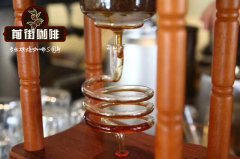The relationship between altitude, variety and coffee flavor? What are the advantages of coffee beans grown at high altitude?

Professional coffee knowledge exchange more coffee bean information please follow the coffee workshop (Wechat official account cafe_style)
The relationship between altitude, variety and coffee flavor? What are the advantages of coffee beans grown at high altitude? What are the characteristics of the flavor?
The main results are as follows: (1) the size of beans is positively correlated with altitude, and it is easier to produce full-shaped beans at high altitude, so some producing areas like to determine the grade of beans by bean size rather than hardness. However, the bean size is related to the variety, and the body shape is not the best rating standard.
(2) the caffeine content in Arabica is positively correlated with the planting altitude, and the caffeine content increases by 10% for every 300 meters. Caffeine in Guatemala at 1400 meters above sea level is about 10 percent higher than coffee at 1100 meters. On the contrary, chlorogenic acid is inversely proportional to altitude, with each increase of 300 meters, the chlorogenic acid in coffee decreases by 5%, which may be related to the disease-resistant system of coffee; the lower the altitude, the more susceptible to disease, so the higher the chlorogenic acid. Luyuan green is also one of the original culprits of bitter coffee, which explains why the lower the altitude of coffee, the less elegant the sour taste. Coffee trees have the highest content of chlorogenic acid in plants. The chlorogenic acid stored in coffee beans alone accounts for 60.8% of the weight of Arabica beans and more than 10% of Arabica beans. The content of chlorogenic acid in coffee trees will increase with the deterioration of the environment, such as high temperature, dryness, and insect pests. The heavier the pressure on plants to survive, the higher the chlorogenic acid will be, but this organic acid is one of the sharp weapons for plants to resist diseases and insect pests. That's interesting. The more neglected the coffee farmers take care of the coffee trees, or the more sinister the growing environment, the higher the chlorogenic acid content of the coffee beans, and the more sour and bitter the coffee will be, as if the coffee also has spirituality: "if you don't take care of me carefully, I'll give you bitter coffee!" "on the other hand, the carefully planted coffee farm is suitable for soil and water, with a large temperature difference between day and night, foggy, and surrounded by shade trees. Such a good Arabica tree makes it grow carefree, and the concentration of chlorogenic acid is relatively low, so it is easy to produce good coffee with sweet and sour and fruity aromas. Therefore, the content of chlorogenic acid can also determine the "regional taste" of coffee, which is particularly important for boutique coffee.
Coffee fans often fall into the myth of coffee-producing countries, thinking that coffee from a certain country belongs to a category with thick pulp or strong sour taste, or that beans from a certain country must be soft beans, and so on. This is a narrow view that you can't see the forest for the trees. It is true that the producing country affects the flavor of coffee, but the more important determinants are latitude, altitude and variety. The closer to the equator, the hotter the climate, the higher the altitude in order to grow extremely hard beans. On the other hand, in the subtropics, which are slightly farther from the equator, the temperature is lower, and the elevation may be lower than that in the tropics, and hard beans can be grown or close to very hard beans.
For example, countries such as Colombia, Kenya and Ethiopia are located near the equator at latitudes less than 10 degrees, so extremely hard beans are planted at higher elevations, ranging from 3,600 feet (about 1100 meters) to 6300 feet (2,000 meters). Because of the abundant rainfall, it can be harvested twice a year. In addition, the producing areas of southern Brazil, Zimbabwe, Mexico, Jamaica and Yunnan are slightly farther from the equator and are subtropical at latitudes between 15 and 24 degrees. Hard beans can be grown at an altitude of about 1,800 feet (550m) to 3600 feet (1100 meters), but the climate in this area varies from dry to wet seasons and can only be harvested once a year.
Try not to use the producing country as the standard to distinguish between beans and categories, but also consider the altitude, latitude and variety of the producing areas in order to more accurately grasp the properties of beans. It is generally believed that Brazil belongs to soft beans because the elevation is often less than 1000 meters, but don't forget that Brazil has a subtropical climate, and it is not necessary to grow extremely hard beans at an altitude of 1500 meters. Brazil's award-winning boutique beans are about 1200 meters above sea level, or even less than 1100 meters above sea level, but they are as elegant and sour as red wine. If Guatemalan coffee trees are planted below 1200 meters, extremely hard beans cannot be planted at this altitude because of low latitudes. The safest way to distinguish bean sex is based on altitude, latitude and variety, which is more professional.
In addition, the bean grain size is closely related to the variety and cultivation environment. The study found that 80% iron is more than 17 mesh wider than Kadou-that is, 6.75 mm-but only 65% of bourbon beans meet this standard. The bean size of the main varieties of boutique coffee is Tibica > Kaddura > Kaduai. However, it should be noted that variety is not the only factor that determines the size of soybean grains. Soil nutrients, environmental pressure and planting density also directly affect the size of beans. If the planting environment is not good, even the beans of Tibica will shrink to less than 15 mesh. Coffee trees with insufficient nutrients are easy to produce low-density floating beans and defective beans.
Important Notice :
前街咖啡 FrontStreet Coffee has moved to new addredd:
FrontStreet Coffee Address: 315,Donghua East Road,GuangZhou
Tel:020 38364473
- Prev

The relationship between altitude, variety and coffee flavor? What are the advantages of high-altitude coffee?
Professional coffee knowledge exchange more coffee bean information please pay attention to the coffee workshop (Wechat official account cafe_style) altitude, variety and coffee flavor relationship? What are the advantages of high-altitude coffee? What kind of coffee varieties should be planted in what environment, which involves complex genetic traits and ecosystems, has become the hottest field of coffee science in recent years. French Center for International Agricultural Development
- Next

What is the relationship between altitude and coffee flavor? What is the difference between coffee beans grown at low altitude and high altitude?
Professional coffee knowledge exchange more coffee bean information please follow the coffee workshop (Wechat official account cafe_style) the relationship between altitude and coffee flavor? What is the difference between coffee beans grown at low altitude and high altitude? The quality of coffee produced in every place is not the same, not as good, not as bad. In terms of coffee bean quality factors, the first two important factors
Related
- Detailed explanation of Jadeite planting Land in Panamanian Jadeite Manor introduction to the grading system of Jadeite competitive bidding, Red bid, Green bid and Rose Summer
- Story of Coffee planting in Brenka region of Costa Rica Stonehenge Manor anaerobic heavy honey treatment of flavor mouth
- What's on the barrel of Blue Mountain Coffee beans?
- Can American coffee also pull flowers? How to use hot American style to pull out a good-looking pattern?
- Can you make a cold extract with coffee beans? What is the right proportion for cold-extracted coffee formula?
- Indonesian PWN Gold Mandrine Coffee Origin Features Flavor How to Chong? Mandolin coffee is American.
- A brief introduction to the flavor characteristics of Brazilian yellow bourbon coffee beans
- What is the effect of different water quality on the flavor of cold-extracted coffee? What kind of water is best for brewing coffee?
- Why do you think of Rose Summer whenever you mention Panamanian coffee?
- Introduction to the characteristics of authentic blue mountain coffee bean producing areas? What is the CIB Coffee Authority in Jamaica?

